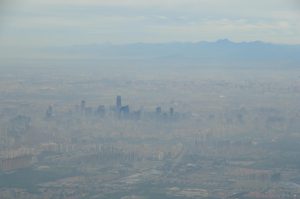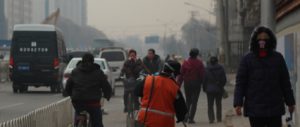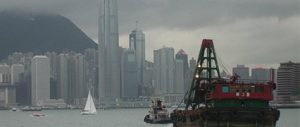The last few days of the Year of the Rabbit marked a watershed in Hong Kong’s ongoing battle with poor air quality. On January 2, the Environmental Protection Department (EPD) announced that, in 2011, roadside air pollution exceeded its current targets a record-breaking 20% of the time, compared to just 2% in 2005.
The same day, Hong Kong-based NGO Clean Air Network released a review of air quality in 2011. This included a table from the 2011 China Statistical Yearbook ranking Hong Kong’s nitrogen dioxide levels (a key indicator of roadside pollution) 31st out of 32 major cities in China. Only Urumqi was worse. This reflects poorly on Hong Kong, which is the richest city in China and has the best infrastructure for environmental protection.
Adding insult to injury, China’s Ministry of Environmental Protection (MEP) pre-empted the long-delayed release of the Hong Kong government’s air quality objectives (AQOs) by announcing AQOs of its own in the same week. This is embarrassing for Hong Kong officials. By dithering for two years after consulting the public on a set of draft AQOs in 2009, they have forfeited Hong Kong’s position as the pace-setter for introducing tougher air-quality standards in China.
Clearly feeling the heat, Hong Kong’s secretary for the environment, Edward Yau, announced on January 17 that the Executive Council had approved new AQOs for Hong Kong and that, following the necessary legislative amendment, they would become law in 2014.
These AQOs are identical to those put out for public consultation in 2009 and, under Hong Kong law, there is in fact no need for new legislation. Section 7(3) of the Air Pollution Control Ordinance states explicitly that the secretary need only consult the Advisory Council on the Environment before introducing AQOs – a much swifter process. Unsurprisingly, a growing body of opinion is questioning the reasons behind the delay.
In a May 2011 meeting of Hong Kong’s Legislative Council, frustrated lawmakers suggested that the government was holding back from releasing the new AQOs because it feared planned infrastructure projects may fail to meet the new standard. In his response, chief executive Donald Tsang appeared to confirm this view: “We must carefully assess the economic and social impacts of any new AQOs on Hong Kong. It is only by doing so that we can put forward any long-term and firmly established AQOs that are appropriate to all works projects and economic development.”
However cynical this seems, his concerns have ample justification. Hong Kong’s high levels of pollution raise serious doubts about the ability of future projects to meet the new AQOs as required under the Environmental Impact Assessment Ordinance (EIAO).
In September last year, the Hong Kong Airport Authority released a report expressing concern that high nitrogen dioxide emissions from aircraft using its proposed third runway would create difficulties in securing approvals under the EIAO, and therefore could not legally go ahead.
In a similar vein, concerns about the public health impacts of air pollution from road vehicles using the Hong Kong-Zhuhai-Macau Bridge provoked the judicial review that held that project up for two years. These projects provide clear evidence that poor air quality now threatens Hong Kong’s economic health as surely as the health and wellbeing of the public.
How did the Hong Kong government find itself in this dilemma? A week after EPD announced Hong Kong’s worst ever levels of roadside pollution, public policy think tank Civic Exchange released a report assessing the government’s recent performance: "Air Quality: Report Card of the Donald Tsang Administration (2005–2012) (DT Report Card)”.
This paper presented data from the Hedley Environmental Index, a project that monitors the costs of Hong Kong’s air pollution, showing that roadside levels of nitrogen dioxide have risen unchecked and that an estimated 7,240 premature deaths, 528,388 avoidable hospital bed days and 49.26 million avoidable doctor visits, can be attributed to Hong Kong’s poor air quality during Tsang’s term of office.
A revised version of the index released five days later was even bleaker in its estimations of the impacts on public health, putting premature deaths at an average of 3,200 each year, more than three times the previous annual estimate of 1,000. Speaking at its launch, professor Anthony Hedley, after whom the index is named, noted worse may be still to come:“Even though these new figures are substantially higher, the truly frightening thing about them is that they are still conservative as they account only for the short-term health impacts of Hong Kong’s air pollution.
“Studies from other jurisdictions strongly suggest that the impacts will be larger still when data from cohort studies, which measure the long-term impacts, are also incorporated.”
These numbers do not mean the Hong Kong government has been idle, however, or that all of its proposed control measures have been ineffective. It successfully reduced sulphur dioxide emissions by making it compulsory for coal-fired power plants to fit flue gas desulphurisation equipment by early 2011.
The problem is more a lack of urgency in targeting the most serious threats to public health. Emissions from vehicles, for example, have been addressed by schemes that require new vehicles to meet the highest standards, but do not force the oldest and most polluting off the road. Another scheme offering incentives for the replacement of ageing buses and trucks failed to take account of the shrinking haulage market. A “cash for clunkers” scheme, offering money to owners looking to exit the sector, may have been more effective.
In addition to reviewing all of the major control measures implemented and proposed from 2005 to 2012, Civic Exchange’s paper outlines how four types of systemic disconnect have blighted even the best-intentioned of the EPD’s control strategies. Some predate the current term by many years, but others are newly created or were not addressed when the opportunity arose.
The first disconnect is in policy. Government has never articulated an integrated policy framework for reducing air pollution that includes time-bound targets and a clearly communicable objective to concentrate the minds of officials, legislators and the wider community. As a result, any ground gained by successful initiatives has often been lost due to a lack of supporting measures addressing other pollutants or a suitable follow-up strategy. The reluctance to adopt AQOs that will drive down pollution is a key omission.
The second is scientific. Currently, there is no appropriately qualified government body responsible for measuring or preventing the public health impacts of air pollution. While EPD is responsible for controlling emissions, it has no expertise in assessing health impacts or determining the best strategies to reduce them. This duty should fall to the Department of Health, which has had no responsibility in this regard since 1989.
Emitters of large quantities of pollutants do not cause the greatest harm to public health, but rather high concentrations of pollutants in poorly ventilated places where many people are directly exposed – the roadsides in Hong Kong’s street canyons. EPD’s control measures have prioritised reductions from major sources such as power stations, but emissions from poorly maintained and ageing buses, trucks and taxis and from ocean-going vessels are the key contributors of the most harmful street-level concentrations, despite the comparatively lower tonnages they emit.
Thirdly, there are administrative failings. In 1989, oversight of the APCO and the setting of the AQOs was passed from the secretary of health and welfare to the secretary for planning, environment and lands. This responsibility has remained with the environment portfolio ever since. As a result, the underlying purpose for managing air quality – protecting public health – has been lost, as evidenced by the 25-year gap since Hong Kong’s AQOs were last updated.
More recently, in 2005, the role of Hong Kong’s environmental regulator – the director of environmental protection – was merged with that of the permanent secretary of the environment, whose job is to streamline the formulation and implementation of government policy. This creates a troubling conflict of interest when decisions on core development projects (for example the proposed third runway for the airport, which will generate some HK$132 billion in contracts and HK$900 billion in economic stimulus for Hong Kong) are expected to have a negative environmental impact. The decision to approve the project rests with a director who has a duty both to implement government policy and to protect the environment.
The final disconnect is in the political arena. While EPD bears the brunt of public frustration for the lack of progress in improving air quality, it receives little support from legislative and district councillors, who consistently prioritise the livelihood interests of their constituents over wider public health concerns. As a result, EPD has been unable to secure support for control measures that would increase costs to polluters. The refusal to introduce higher licensing fees for older and more polluting diesel buses and trucks is just one example.
Civic Exchange separated its policy recommendations into a companion report, setting out seven initiatives that could swiftly reduce air pollution where it poses the greatest threats to public health, supported by seven guiding principles.
These principles are: one, create a time-bound and target-based policy framework. Two, return oversight of the Air Pollution Control Ordinance and AQOs to the secretary for health. Three, immediately introduce new AQOs for Hong Kong. Four, prioritise measures that swiftly reduce the threat to health – especially roadside emissions. Five, develop control measures that combine “sticks” with “carrots”. Six, set out a roadmap for progressive tightening of standards. And, seven, re-professionalise key posts in EPD to improve decision-making and reduce potential conflicts of interest.
These aim to help policymakers develop co-ordinated and time-bound measures to reduce pollutant concentrations where they pose the greatest threat to health – congested and crowded roadsides in districts such Causeway Bay and Mong Kok, and around the port.
It is here that a new scheme offers a glimmer of hope. In November 2011, EPD officials tabled a proposal to combine the subsidised replacement of catalytic converters for LPG-powered public light buses and taxis (which could reduce their nitrogen dioxideemissions by 90% or more) with on-road monitoring of LPG and petrol vehicles, against a newly-established standard.
Not only has EPD targeted the most important source of high roadside concentrations of the key pollutant with this proposal, it has also combined the “carrot” of a free convertor replacement with the “stick” of upgraded enforcement. Better still, EPD has secured industry buy-in by demonstrating that converter replacement improves vehicle performance and fuel efficiency. This increases the likelihood that they will find the necessary support from legislators when the legislation is introduced.
Mike Kilburn is head of environmental strategy at Civic Exchange.
Homepage image by Design for Health



